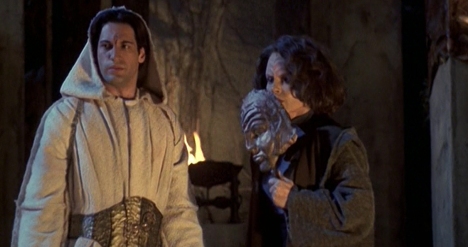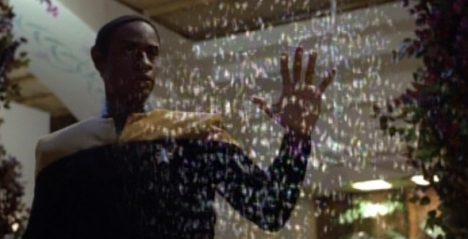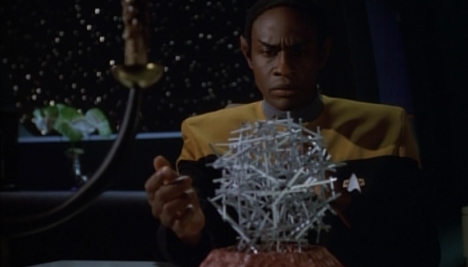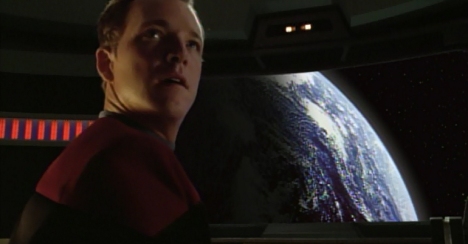In its own way, Muse marks the end of an era for Star Trek: Voyager, as Joe Menosky’s last solo script for the series.
To be fair, this is not Menosky’s last script credit on the series. Menosky would collaborate with Brannon Braga on the season-bridging two-parter Unimatrix Zero, Part I and Unimatrix Zero, Part II. In fact, those episodes have themes that play directly into Menosky’s interests; the two-parter is a story about dreams and narratives, about worlds that exist beyond the literal and the concrete. More than that, Menosky would work on the writing staff of Star Trek: Discovery, contributing the script to Lethe, one of the season’s stand-out episodes that was also about narratives – albeit internalised ones.

Dropping the mask.
However, Muse still feels like it marks the end of an era. Menosky had been a fixture of the Berman era of Star Trek dating back to the fourth season of Star Trek: The Next Generation, making his debut with Legacy and arguably making his biggest impression with Darmok early the following season. Menosky’s involvement with the franchise ebbed and flowed in the intervening years, but his influence was often felt. Indeed, Menosky even contributed a handful of scripts and stories to Star Trek: Deep Space Nine, including the teleplay for the underrated Dramatis Personae.
With Menosky’s departure from Voyager at the end of the sixth season, Brannon Braga would become the longest-serving writer working on the Star Trek franchise. His tenure on the television franchise would surpass that of Ronald D. Moore, and of any writer who hadn’t spanned the gap from the end of the original Star Trek to the early seasons of The Next Generation, with the arguable exception of producer Rick Berman. As such, Muse feels very much like the end of an era. It marks the departure of one of the guiding light of the Star Trek franchise, albeit one often overlooked or ignored.

Storyteller.
Muse is an episode that speaks to Menosky’s key interests within the Star Trek franchise, the idea of Star Trek as something akin to a modern mythology. More than any other writer on Star Trek, Menosky is invested in stories that are fundamentally about stories. His influence on Voyager is more subtle than that of Michael Piller, Jeri Taylor or Brannon Braga, but can felt in the recurring idea that Voyager itself is a Delta Quadrant myth. More than any of the other Star Trek series, Voyager feels like it is a story about a collection of archetypes rather than characters.
Menosky first articulated this idea in the closing scene of his otherwise forgettable script for False Profits, but reinforced it in episodes like Distant Origin, Living Witness and Blink of an Eye. It could reasonably be argued that this idea became part of the show’s identity, to the point that it can even be traced through episodes not explicitly credited to Menosky, like Live Fast and Prosper. It seems appropriate that this idea should serve as the central theme of Muse, an episode that might be read as a thesis statement on Menosky’s approach to the franchise.

Acting out.
Filed under: Voyager | Tagged: elements, Joe Menosky, Muse, mythology, optimism, Peace, star trek, star trek: voyager, storytelling, voyager, war, words, writing | 5 Comments »







































